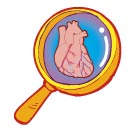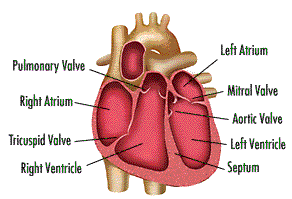

|
We see and hear about hearts everywhere. A long time ago, people even thought
that their emotions came from their hearts, maybe because the heart beats faster
when a person is scared or excited. Now we know that emotions come from the brain, and that the brain tells
the heart what to do. So what's the heart up to, then? How does it keep busy?
What does it look like? Let's find out. Working That Muscle Your heart is sort of like a pump, or two pumps in one. The right side of your heart receives blood from the body and pumps it to the lungs. The left side of the heart does the exact opposite: It receives blood from the lungs and pumps it out to the body. We Got the Beat Heart Parts The two chambers on the bottom are called the ventricles (say: ven-trih-kulz). Their job is to squirt out the blood to the body and lungs. Running down the middle of the heart is a thick wall of muscle called the septum (say: sep-tum). The septum's job is to separate the left side and the right side of the heart. The atria and ventricles work as a team - the atria fill with blood, then dump it into the ventricles. While the ventricles pump blood out of the heart, the atria refill and get ready for the next contraction. So when the blood gets pumped, how does it know which way to go? Well, your blood relies on four special valves inside the heart. A valve lets something in and keeps it there by closing - think of walking through a door. The door shuts behind you and keeps you from going backward. Two of the heart valves are the mitral (say: my-trul) valve and the tricuspid (say: try-kus-pid) valve, and they let blood flow from the atria to the ventricles. The other two are called the aortic (say: ay-or-tic) valve and pulmonary (say: pul-muh-ner-ee) valve, and they're in charge of controlling the flow as the blood leaves the heart. These valves all work to keep the blood flowing forward. They open up to let the blood move ahead, then they close quickly to keep the blood from flowing backward.
|

 |
 |
 |
 Did you give your friends valentines and little heart-shaped
candies on Valentine's Day? Do you ever cross your heart when making a promise
that you really, really mean? Or turn on the radio to hear a guy singing about
his broken heart?
Did you give your friends valentines and little heart-shaped
candies on Valentine's Day? Do you ever cross your heart when making a promise
that you really, really mean? Or turn on the radio to hear a guy singing about
his broken heart?
 ia (say: ay-tree-ah, but if you're
only talking about one, then say atrium). The atria are the chambers that fill
with the blood returning to the heart from the body and lungs.
ia (say: ay-tree-ah, but if you're
only talking about one, then say atrium). The atria are the chambers that fill
with the blood returning to the heart from the body and lungs.


